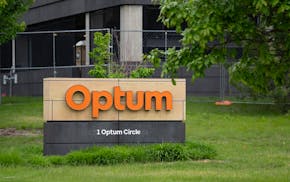There are so many moving parts in the advertising industry, it's become difficult for digital marketing agency head Nicole Newville to explain what direction the industry is heading.
Advances in technology have led to algorithms, not humans, deciding how and where advertisements are placed online, and she's one of many ad professionals concerned about the impact of artificial intelligence — plus there are still billboards, print and TV ads.
"The lines are becoming so blurry," said Newville, the founder and president of Kose, a Minneapolis-based digital marketing agency. "It used to be your highest reaching channel was television. You do that buy and do a cable buy and you've reached 90% of your audience. Now we have cord cutters, and we have people who have never had a cord."
The disruption has led to new marketing and ad agencies that concentrate more on digital opportunities and data — and a consolidation of traditional firms, which themselves have added units addressing the new reality. It also means a resurgence of billboards as a way to keep advertising messages in places people cannot avoid.
Upended by digital growth
Digital advertising is now taking the lead in marketing plans after years of slow growth, said Anton Friant, president of the Advertising Federation of Minnesota, a nonprofit professional trade association. Yet, that involves developing strategies that work with online algorithms so ads land in the right spots.
Through the first nine months of 2022, agencies spent $14.6 billion on digital video advertisements in the U.S., up from $14.5 billion in 2021 and far more than the $5.4 billion spent on digital ads in 2020, according to marketing research firm Nielsen.
It's a growing segment, and it's swelling profits of tech behemoths Facebook and Google. For its recent fourth quarter alone, Google generated $59 billion from its advertising business, in addition to $7.9 billion from ads on YouTube, which it owns.
Even though it was down from 2021, Meta, the parent company of Facebook, generated $31.2 billion in revenue for its 2022 fourth quarter.
Still, while digital accounts for a large sum of ad budgets, it's small in comparison to the nearly $300 billion on all forms of advertising in 2021, according to Statista.
Per Nielsen's findings, half of marketing executives in North America view spending on internet-connected television sets, which have built-in streaming platforms such as Hulu and Amazon Prime, as ineffective, given the low quality of insight and measurement around the investment.
With so much content on demand, reaching millions of viewers all at once, outside of a mega sports event like the Super Bowl, is nearly impossible, Newville said.
"Everything is so self directed and self selected, that linear experience is harder and harder to come by," she said.
Yet, a digital strategy is complicated — beyond the algorithms are also scams that must be avoided.
Marketers "need to have the most sophisticated, single source data," said Linli Xu, an associate professor of marketing at the University of Minnesota's Carlson School of Management. "They need to know all these different touch points by the consumers. How do you measure the effectiveness of different media types and the attribution? They face a lot of challenges, and that's why it's making this problem so difficult to answer."
Going where consumers' eyeballs are
To add certain eyeballs to a strategy, the old is new again — with a twist. In airports, skyways, malls and highways, digital billboards also are often part of the plan, Newville said.
Also think big buildings such as the side of downtown buildings, especially near Target Center and Target Field.
Aside from a down year in 2020 when the pandemic forced people indoors, the out-of-home ad market has accelerated, said Dan Levi, chief marketing officer of New York-based Clear Channel Outdoor.
Those billboards are considered less intrusive forms of media — something consumers are increasingly looking for, Levi said.
The math is simple for ad buyers, too, and no attempts by the consumer to avoid the commercial, he said.
"There's no bots that are creating fake cars that are driving past the billboard," he said. "There's no issues of view other than if a tree is growing in front of it, and we trim the tree to make sure that we're not blocking the billboard."
Nearly half of U.S. adults searched online for a product, or watched a television program within two months of after seeing an "out of home" ad, according to the Out of Home Advertising Association of America.
In its markets, Clear Channel is able to measure the correlation between a person noticing a billboard and following through with either a visit to a store, going to a restaurant or downloading an app, Levi said.
In Minnesota, Clear Channel has more than 1,300 displays that draw 152 million impressions weekly, including six full-motion billboards at Mayo Clinic Square in downtown Minneapolis.
In honor of National Black Business Month, Twin Cities podcaster Sheletta Brundidge purchased ad space on Clear Channel digital billboards in Minneapolis for five Black women business owners. The ads will stay up for two weeks, Brundidge said.
"Advertisers seem to be thinking more holistically about media and realizing, especially with all the data solutions that we have, that you can actually approach out of home in the same way that you approach digital media, streaming video, things like that, but without the problems and with all the benefits," Levi said.
Growth of influencers
Another venue for advertising today, especially for people in the 18- to 34-year-old demographic, is online influencers, who can be podcasters like Brundidge or people who use Instagram or TikTok to spread content.
The younger generation are more likely to trust an influencer's opinion about a brand than a brand itself, according to marketing and public relations firm Edelman.
Seeing this trend, two years ago, Philadelphia-based telecommunications company Comcast, whose Midwest headquarters is in St. Paul, partnered with Brundidge to promote its Comcast Rise initiative, a $1 million grant program that awards checks of $10,000 each to 100 small businesses owned by people of color or women in the Minneapolis-St. Paul region.
Brundidge, a former broadcaster in Minneapolis, in 2020 launched a podcast platform with nearly a dozen shows that cater to African American culture. The network has amassed about 50,000 subscribers who listen to Black-subject experts, with conversations touching mental health, fitness and financial literacy.
"We saw her as a great partner to be able to share some of our important messages in the community," said Jill Hornbacher, senior director of external communications for Comcast's Midwest region.
Brundidge has been contracted by grocers, retailers, and insurers, among them companies like General Mills, Target and UnitedHeathcare for marketing within her podcast and social media accounts.
"People are living in homes and apartments with no television,' Brundidge said. "They are not reading newspapers, but they are listening to podcasts and they are doing on social media to the people they trust and follow."
Agencies changing to react
The digital expertise has resulted in a market that has spurred newer boutique agencies such as Newville's Kose, which employs 20 people.
Still, many bigger national agencies are consolidating and also opening specialized units to compete, still snagging a big portion of business.
Minneapolis full-service creative agency Carmichael Lynch, which was founded in 1962, has grown its headcount over the years to adapt to an evolving, more complicated industry, Chief Executive Marcus Fischer said. Now with more than 300 employees, the company needs tech-focused and nimble workers that embrace innovation and can analyze data around consumer behavior but also offer diverse perspectives.
"As marketing gets harder, we need more people to do that in order to answer those business needs for our clients," Fischer said. "We need to have more disciplines."
Having that kind of staff attracts business, he said. While brands can still seek smaller, specialized firms, a fully capable partner simplifies the advertising process.
"What an agency the size of Carmichael Lynch does, by being fully integrated, means you've got a lot of people, and the benefit of a lot of people is you can go to a client and say 'Hey, I can be a one-stop shop for all your problems."

Delta hiked fares for solo travelers, until Twin Cities travel experts caught the change

In first speech back, UnitedHealth's new CEO pledges to review hot-button issues

A child had measles at Mall of America, concerning state health officials who don't know source

Ramstad: Gov. Walz, things are not getting done in Minnesota

